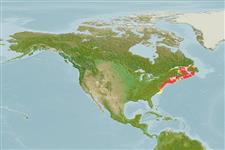Elasmobranchii (sharks and rays) >
Rajiformes (Skates and rays) >
Rajidae (Skates)
Etymology: Leucoraja: Greek, leykos = white + Latin, raja = a fish, Raja sp. (Ref. 45335).
Environment / Climate / Range
Ecology
Marine; demersal; oceanodromous (Ref. 51243); depth range 0 - 120 m (Ref. 93252). Temperate, preferred ?; 51°N - 34°N, 79°W - 55°W (Ref. 55278)
Western Atlantic: Newfoundland Banks and southern Gulf of St. Lawrence in Canada to North Carolina, USA.
Length at first maturity / Size / Weight / Age
Maturity: Lm ?, range 73 - 76 cm
Max length : 110 cm TL male/unsexed; (Ref. 7251); max. reported age: 21 years (Ref. 52109)
Short description
Morphology | Morphometrics
Disk rounded, with many small dark spots on upper surface. Usually 1-4 ocelli on upper surface on each side of disk, each with a dark brownish center and pale edge. Young have long middorsal row of large spines on disk and tail. Upper jaw has 72 rows of teeth (Ref. 7251). Lower surface usually white but marked with irregular pale brownish blotches (Ref. 6902).
Prefer sandy and gravelly bottoms in shoal water in the north range; to at least 90 m in south (Ref. 7251). Benthic (Ref. 5951). Those caught at Cans, Nova Scotia in Canada were found to have eaten dollarfish, cunner, and squid. Mostly inactive during daylight hours, but active under dark conditions (Ref. 10807). Oviparous. Distinct pairing with embrace. Young may tend to follow large objects, such as their mother (Ref. 205). Eggs are oblong capsules with stiff pointed horns at the corners deposited in sandy or muddy flats (Ref. 205). Egg capsules are 5.5-9.9 cm long and 3.5-5.3 cm wide (Ref. 41249, 7135, 71301).
Electric organ discharge (EOD) activity seemed more frequent during dark periods (Ref. 10808). The individual EOD of this species is monophasic, head-negative, and lasts 217 ms (Ref. 10011). This species is used only for the manufacture of fish meal.
Life cycle and mating behavior
Maturity | Reproduction | Spawning | Eggs | Fecundity | Larvae
Oviparous, paired eggs are laid. Embryos feed solely on yolk (Ref. 50449). Distinct pairing with embrace. Young may tend to follow large objects, such as their mother (Ref. 205).
McEachran, J.D. and K.A. Dunn, 1998. Phylogenetic analysis of skates, a morphologically conservative clade of elasmobranchs (Chondrichthyes: Rajidae). Copeia 1998(2):271-290. (Ref. 27314)
IUCN Red List Status (Ref. 115185)
CITES (Ref. 94142)
Not Evaluated
Threat to humans
Harmless
Human uses
More information
ReferencesAquacultureAquaculture profileStrainsGeneticsAllele frequenciesHeritabilityDiseasesProcessingMass conversion
Tools
Special reports
Download XML
Internet sources
